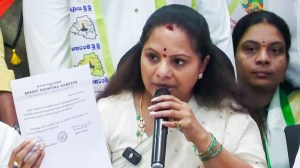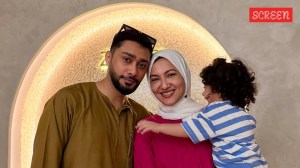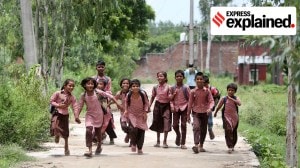Click here to follow Screen Digital on YouTube and stay updated with the latest from the world of cinema.
‘The Kapoors would laugh at us, but watched our films’: Bollywood’s ‘other’ film family also came from Pak, attained ‘sleazy’ success
Hailing from the Sindh province in modern-day Pakistan, the Ramsinghania family moved to Mumbai after the Partition. The patriarch was penniless and destitute, and desperate for money, he decided to join the film business as Ramsay brothers.
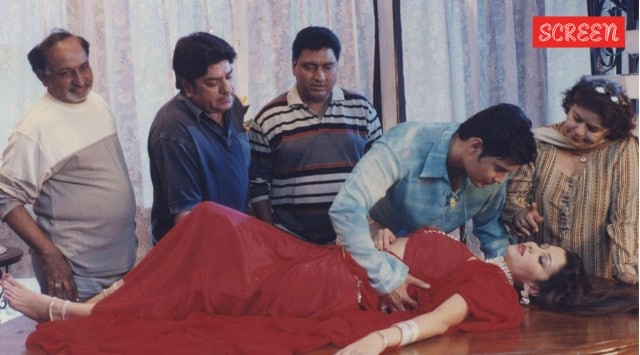 Co-producer Vinod Sharma, director Shyam Ramsay, producer Yashovardhan Tyagi, Amar Upadhayay, Aditi Govitrikar, choreographer Saroj Khan on the set of Dhund: The Fog. Express archive photo
Co-producer Vinod Sharma, director Shyam Ramsay, producer Yashovardhan Tyagi, Amar Upadhayay, Aditi Govitrikar, choreographer Saroj Khan on the set of Dhund: The Fog. Express archive photoSeveral families that emigrated from modern-day Pakistan after the Partition in 1947 went on to found movie studios in cities such as Kolkata and Mumbai. Among them were the Anands and the Kapoors. But one family’s formidable influence on Hindi films is often overlooked. Their rise coincided with that of the Kapoors, but the Raisinghania family from the Sindh province dominated an altogether different corner of the film business. While the Kapoors produced big-budget tent poles featuring major stars, the Raisinghanias made sleazy horror movies with 15-member crews. Their movies were made cheaply, they lacked originality, and were widely panned. But they were hugely successful in smaller towns and villages. These were the movies of the Ramsay Brothers.
According to a research paper authored by Kartik Nair, the family’s patriarch FU Raisinghania changed his name to the British-friendly ‘Ramsay’ because the occupiers couldn’t pronounce his original name. The family ran a ’14-door’ electronics store in Karachi, but was forced to leave everything behind during the Partition. FU Ramsay and his seven sons —Shyam, Tulsi, Kiran, Gangu, Keshu, Arjun, Kumar — moved to Mumbai, where they set up a new electronics business. But money was tight, and the patriarch couldn’t keep things afloat.
FU Ramsay decided to try his hand at film production, and put his money on a string of films that flopped. In 1970, he took the plunge again with a movie titled Ek Nanhi Munni Ladki Thi, starring Mumtaz, Shatrughan Sinha, and Prithviraj Kapoor. The film flopped, but the family was struck by inspiration. Tulsi Ramsay recalled watching the film with a ‘comatose’ audience, but noted that everybody rose out of their stupor the moment Prithviraj Kapoor’s character entered during the film’s night-time heist sequence. He was dressed in full prosthetics. His appearance shocked the audience, who began screaming. Tulsi was struck by a brainwave: “Why don’t we make a full-fledged horror movie?”
 Director Shyam Ramsay, producer Yashovardhan Tyagi, Aditi Gowritrikar, Irfan Khan, Divya Palat and co-Producer Vinod Sharma on the set of Dhund the Fog. Express Archive
Director Shyam Ramsay, producer Yashovardhan Tyagi, Aditi Gowritrikar, Irfan Khan, Divya Palat and co-Producer Vinod Sharma on the set of Dhund the Fog. Express Archive
This idea would change the family’s fortunes forever. They taught themselves filmmaking, and with a ragtag crew made up mostly of their own relatives, they began making their low-budget horror movies. These films were often plagiarised from Hollywood classics such as The Mummy and Dracula, and they featured garish makeup and salacious themes. They rented out a decrepit mansion on the outskirts of Mumbai for a mere Rs 500 a day, hired part-time actors and borrowed the equipment. The brothers’ mother would cook for the entire crew. The movie they made was titled Do Gaz Zameen Ke Neeche.
Ironically, it was during the making of this movie that Tulsi Ramsay accidentally unearthed ‘half’ a dead body. “People working there had shown us where to dig and said: ‘nothing will happen here’,” Tulsi told Motherland Magazine in an interview. The villagers descended on the location and caused an uproar. The brothers managed to pacify them, and reburied the body. They even left a lit lamp on the spot. Do Gaz Zameen Ke Neeche was shot in 40 days on a budget of Rs 3.5 lakh, and it made Rs 45 lakh at the box office. They repeated the same strategy 35 times.
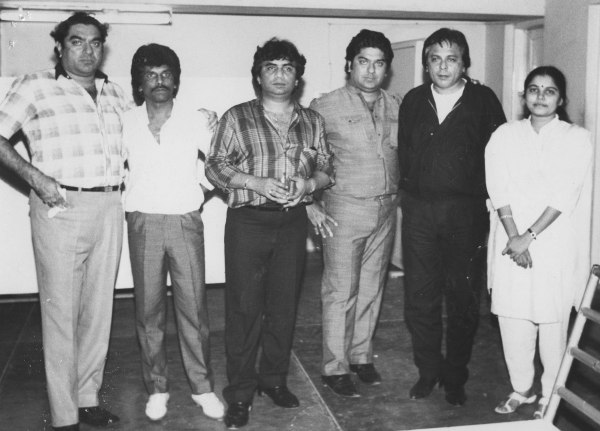 Director Tulsi Ramsay, producers Ali Bhai and Dilip Nagpal, director Shyam Ramsay, music director Ajit Singh and singer Sadhna Sargam in Anokha Darr. Photo by Shailesh Brajesh
Director Tulsi Ramsay, producers Ali Bhai and Dilip Nagpal, director Shyam Ramsay, music director Ajit Singh and singer Sadhna Sargam in Anokha Darr. Photo by Shailesh Brajesh
Some of their films, particularly the 1984 title Purana Mandir, broke out into the mainstream. The movie made Rs 2.5 crore, and caught the attention of bigger Bollywood families, particularly the Kapoors. “They would keep laughing at us and wonder what we brothers were doing. But they would watch our movies,” Tulsi told Motherland Magazine. Incidentally, the patriarch of the Kapoor family was Prithviraj Kapoor, whose appearance in Ek Nanhi Munni Ladki Thi was what inspired the Ramsays to make horror movies.
Reflecting on their process, Tulsi told Motherland Magazine, “Seven of us would share two rooms on the first floor of Ramsay House in those days. After work we would keep planning, discussing scenes, talking business, telling each other ghost stories.” They would place bets on who’d be able to come up with the best story by tea time. Even though the Ramsays couldn’t afford to hire real stars, they knew that they had a star in the monsters they created for their films. “I had Rajesh Khanna. I had Shah Rukh Khan,” Tulsi said about their monster characters.
Dissecting their success in small-town India, Shyam Ramsay told the magazine, “They could relate more to our films because of these locations contrary to an urban setup. Also the fear element can easily be accomplished in far off remote corners rather than cities.” By the 1990s, the landscape had changed to the point where the Ramsays’ formula wasn’t delivering the sort of success that it used to. Filmmaker and journalist Khalid Mohamed said, “I don’t think the Ramsays not making any more movies was a matter of changing tastes or a decline in audience. I think it was because the brothers didn’t work together anymore.” Arjun Ramsay’s son, Deepak, followed in the older generation’s footsteps and made Zee Horror Show for the emerging small screen audience, but by the time the multiplex wave began in the 2000s, the Ramsays were done.
Once again making a reference to their counterparts in the upper echelons of the Hindi film industry, Tulsi said, “You need ‘flame’. We had ‘flame’ when we started out. Like Raj Kapoor had ‘flame.’ Like Ranbir Kapoor has ‘flame’ now. Shyam and I keep talking about this.” By 2019, both Tulsi and Shyam were dead. The Oscar-nominated directors Sushmit Ghosh and Rintu Thomas made a documentary about the Ramsays, and told Indian Express, “The Ramsays created a syntax for a unique cinematic language that had never existed in Hindi cinema. The recent passing of Tulsi and now Shyam highlights a deep irony facing most artists in India — that their work might never be celebrated in their own lifetimes.”


Photos
- 01
- 02
- 03
- 04
- 05













